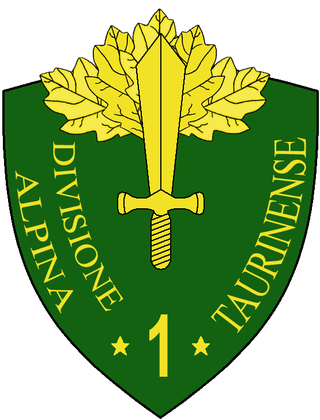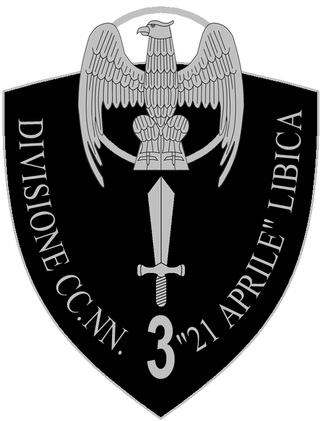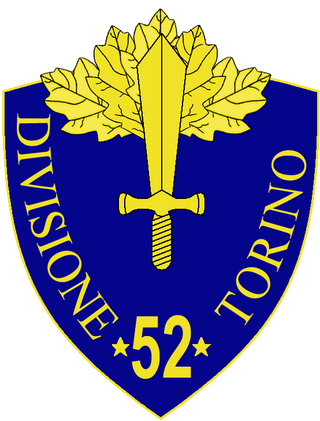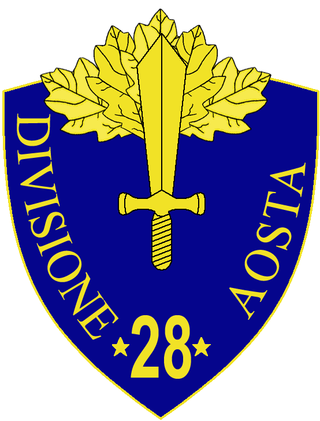
The 1st CC.NN. Division "23 Marzo" was an Italian CC.NN. division raised on 23 April 1935 for the Second Italo-Ethiopian War against Ethiopia. The name "23 Marzo" was chosen to commemorate the founding date of the Fasci Italiani di Combattimento on 23 March 1919. The division took part in the Italian invasion of Egypt and was destroyed during the Battle of Bardia in January 1941.
The Order of battle of the East African campaign shows the ground forces of both sides in East Africa on the date that the Italians declared war on Britain and France, 10 June 1940 and for the British and Commonwealth forces involved in the 1941 offensive.

The 1st Alpine Division "Taurinense" was a division of the Royal Italian Army during World War II, which specialized in mountain warfare. The Alpini that formed the division are a highly decorated and elite mountain corps of the Italian Army consisting of both infantry and artillery units. Today, the traditions and name of the 1st Alpine Division "Taurinense" are carried on by the Alpine Brigade "Taurinense". The headquarters of the division was in the city of Turin and the majority of its soldiers were drafted from the surrounding Province of Turin — therefore the division was named "Taurinense" for the Roman name of the city of Turin Augusta Taurinorum.

The 2nd CC.NN. Division "28 Ottobre" was an Italian CC.NN. division raised on 10 May 1935 for the Second Italo-Ethiopian War against Ethiopia. The name "28 Ottobre" was chosen to commemorate the Fascist March on Rome on 28 October 1922. The division took part in the Italian invasion of Egypt and was destroyed during the Battle of Bardia in January 1941.

The 3rd CC.NN. Division "21 Aprile" was an Italian CC.NN. division raised on 10 June 1935 for the Second Italo-Ethiopian War against Ethiopia and disbanded shortly before Italy's entry into World War II. The name "21 Aprile" was chosen to commemorate the legendary date of the founding of Rome.

The 4th CC.NN. Division "3 Gennaio" was an Italian CC.NN. division raised on 25 June 1935 for the Second Italo-Ethiopian War against Ethiopia. The name "3 Gennaio" was chosen to commemorate the date of assumption of dictatorial powers by Benito Mussolini on 3 January 1925. The division took part in the Italian invasion of Egypt and was destroyed during the Battle of Sidi Barrani in December 1940.
The 1st CC.NN. Division "Dio lo Vuole", was one of the three Italian Blackshirts Divisions sent to Spain during the Spanish Civil War to make up the "Corpo Truppe Volontarie", or CTV.
2nd CC.NN. Division "Fiamme Nere", was one of the three Blackshirts Divisions sent to Spain during the Spanish Civil War to make up the "Corpo Truppe Volontarie", or CTV. Was strengthened after the end of the War in the North for the Aragon Offensive in 1938 with Division XXIII di Marzo and renamed XXIII Marzo Division "Fiamme Nere".
The XXIII de Marzo Group was one of the Blackshirt units sent to Spain during the Spanish Civil War to make up the "Corpo Truppe Volontarie", or CTV. This unit was attached to the 2nd CCNN Division "Fiamme Nere" during the Battle of Guadalajara in March 1937. Following defeat there, it was sent to Vizcaya in April 1937 with the Flechas Negras Mixed Brigade and 11 Groups of CTV Corps Artillery.
This is the order of battle for the Battle of Guadalajara during the Spanish Civil War.
The Agrupación XXIII de Marzo was upgraded to Division status as the Division XXIII Marzo prior to the Battle of Santander. It was one of the Italian Blackshirts units sent to Spain during the Spanish Civil War to make up the "Corpo Truppe Volontarie", or CTV. Was strengthened after the end of the War in the North for the Aragon Offensive in 1938 with 2nd CCNN Division "Fiamme Nere" and renamed XXIII Marzo Division "Fiamme Nere".

The 4th Infantry Division "Livorno" was a infantry division of the Royal Italian Army during World War II. The Livorno was classified as a mountain infantry division, which meant that the division's artillery was moved by pack mules instead of the horse-drawn carriages of line infantry divisions. Italy's real mountain warfare divisions were the six alpine divisions manned by Alpini mountain troops. The Livorno was formed on 5 April 1939 in Cuneo and named for the city of Livorno.

The 1st Infantry Division "Superga" was an infantry division of the Royal Italian Army during World War II. The Superga was classified as a mountain infantry division, which meant that the division's artillery was moved by pack mules instead of the horse-drawn carriages of line infantry divisions. Italy's real mountain warfare divisions were the six alpine divisions manned by Alpini mountain troops. The Superga recruited primarily from central Piedmont and was based, together with its two infantry regiments, in Turin, while the 5th Artillery Regiment was based in Venaria Reale. The division was and named for the Superga hill near Turin, where members of Italy's Royal House of Savoy were buried in the Basilica of Superga.

The 52nd Infantry Division "Torino" was an infantry division of the Royal Italian Army during World War II. The Torino was named after the city of Turin and classified as an auto-transportable division, meaning it had some motorized transport, but not enough to move the entire division at once. The division was formed by expanding the Torino Brigade in June 1940 and was based with two of its regiments in Civitavecchia, while the 81st Infantry Regiment "Torino" was based in Rome. The division took part in the Invasion of Yugoslavia and was then sent to the Eastern front as part of the Italian Expeditionary Corps in Russia.

The 136th Armored Legionary Division "Centauro" was an armored division of the Royal Italian Army during World War II. The division had been formed in June 1942 as 1st CC.NN. Armored Division "M", but was renamed after the fall of the fascist regime in July 1943. In September 1943 it was in training near Rome and was disbanded by the Germans after the announcement of the Armistice of Cassibile.

The 20th Infantry Division "Friuli" was an infantry division of the Royal Italian Army during World War II. The Friuli was formed on 24 August 1939 by splitting the 20th Infantry Division "Curtatone e Montanara" into the Friuli and the 44th Infantry Division "Cremona". The Friuli was named for the region of Friuli, but based in Tuscany, where it also recruited most of its troops. The division's headquarter and its regiments, with the exception of the 87th Infantry Regiment located in Siena, were based in Livorno. The division served as occupation force on Corsica and fought German units after the Armistice of Cassibile was announced on 8 September 1943. The division then served with the Italian Co-belligerent Army and remained active into the early stages of the Cold War.

The 21st Infantry Division "Granatieri di Sardegna" was an infantry division of the Royal Italian Army during World War II. The division's name translates as "Grenadiers of Sardinia", referring to the Kingdom of Sardinia ruled by the Italian Royal House of Savoy before the unification of Italy as Kingdom of Italy.

The 28th Infantry Division "Aosta" was an infantry division of the Royal Italian Army during World War II. The Aosta was formed for the first time in 1831 and named for the city of Aosta. The division fought in the Allied invasion of Sicily and its remnants were evacuated to Northern Italy, where the division's remnants were disbanded after the Armistice of Cassibile.

The 53rd Infantry Division "Arezzo" was a infantry division of the Royal Italian Army during World War II. The Arezzo was classified as a mountain infantry division, which meant that the division's artillery was moved by pack mules instead of the horse-drawn carriages of line infantry divisions. Italy's real mountain warfare divisions were the six alpine divisions manned by Alpini mountain troops.

The Voluntary Militia for National Security, commonly called the Blackshirts or squadristi, was originally the paramilitary wing of the National Fascist Party, known as the Squadrismo, and after 1923 an all-volunteer militia of the Kingdom of Italy under Fascist rule, similar to the SA. Its members were distinguished by their black uniforms and their loyalty to Benito Mussolini, the Duce (leader) of Fascism, to whom they swore an oath. The founders of the paramilitary groups were nationalist intellectuals, former army officers and young landowners opposing peasants' and country labourers' unions. Their methods became harsher as Mussolini's power grew, and they used violence and intimidation against Mussolini's opponents. In 1943, following the fall of the Fascist regime, the MVSN was integrated into the Royal Italian Army and disbanded.













